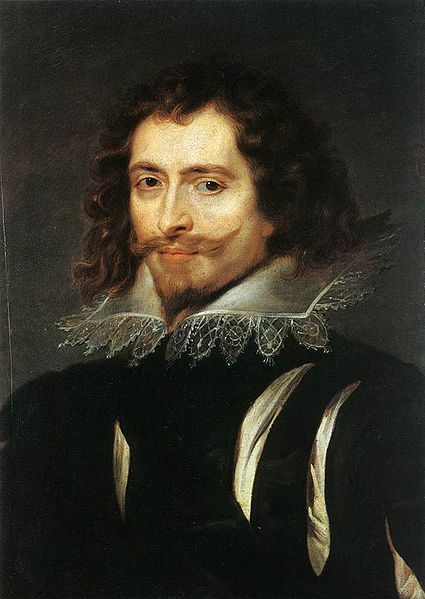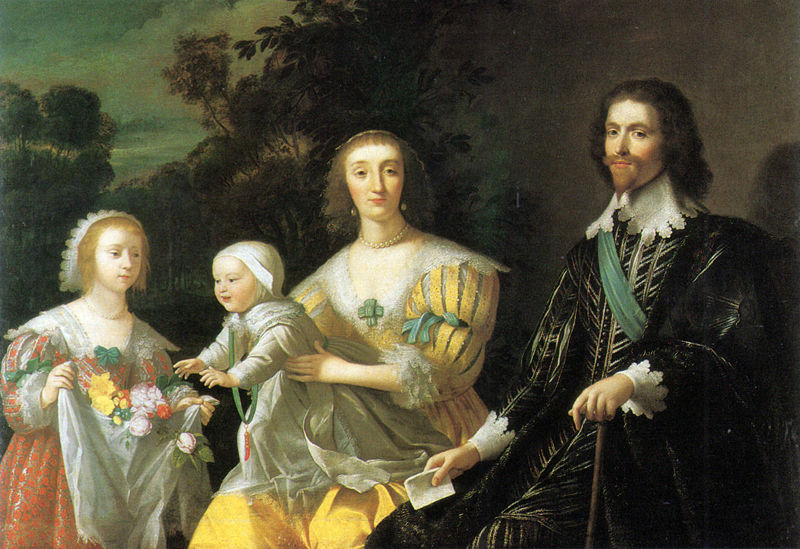<Back to Index>
- Economist Antoine Augustin Cournot, 1801
- Painter Edward Coley Burne - Jones, 1833
- 1st Duke of Buckingham George Villiers, 1592
PAGE SPONSOR


George Villiers, 1st Duke of Buckingham KG (28 August 1592 – 23 August 1628) was the favourite, claimed by some to be the lover, of King James I of England. Despite a very patchy political and military record he remained at the height of royal favour for the first two years of the reign of Charles I, until he was assassinated. He was one of the most rewarded royal courtiers in all history.
He was born in Brooksby, Leicestershire, in August 1592, the son of the minor gentleman Sir George Villiers (1550 – 1604). His mother, Mary (1570 – 1632), daughter of Anthony Beaumont of Glenfield, Leicestershire, who was left a widow early, educated him for a courtier's life, sending him to France with Sir John Eliot.
George Villiers took very well to the training set by his mother; he could dance well, fencewell, and speak a little French. In August 1614, Villiers, reputedly "the handsomest bodied man in all of England," was
brought before the king, in the hope that the king would take a fancy
to him, diminishing the power at court of then favourite Robert Carr, 1st Earl of Somerset. Following
Villiers' introduction to James during the king's progress of that
year, the king developed a strong affection for Villiers, calling him
his 'sweet child and wife'; the personal relationships of James are
a much debated topic, with Villiers making the last of a succession of
favourites on whom James lavished affection and rewards. The extent to
which there was a sexual element, or a physical sexual relationship,
involved in these cases remains controversial. Villiers reciprocated
the king's love and wrote to James: "I naturally so love your person,
and adore all your other parts, which are more than ever one man had"
and "I desire only to live in the world for your sake". Restoration of Apethorpe Hall in 2004 – 2008 revealed a previously unknown passage linking his bedchamber with that of James. Villiers
gained support from those opposed to the current favourite, Robert
Carr, 1st Earl of Somerset, and under the king's patronage he prospered
greatly. Villiers was knighted in 1615 as a Gentleman of the Bedchamber, and was rapidly advanced through the peerage: he was created Baron Whaddon and Viscount Villiers in 1616, Earl of Buckingham in 1617, Marquess of Buckingham in 1618 and finally Earl of Coventry and Duke of Buckingham in 1623. After the reductions in the peerage that had taken place during the Tudor period, Buckingham was left as the highest ranking subject outside the royal family. In the 1620s, Villiers acquired York House, Strand, the street linking the City of London to that of Westminster. Apart from an interlude during the English Civil War, the property remained in the family until his son sold
it to developers for £30,000 in 1672. He made it a condition of
the sale that his name and title be commemorated by George Street, Villiers Street, Duke Street, Of Alley, and Buckingham Street, some of which have survived into the 21st century.
Buckingham married the daughter of the 6th Earl of Rutland, Lady Katherine Manners, later suo jure Baroness de Ros, on 16 May 1620 despite the objections of her father. Buckingham was happy to grant valuable royal monopolies to her family.
From 1616, Buckingham established a dominant influence in Irish affairs, beginning with the appointment of his client, Sir Oliver St John, as Lord Deputy,
1616 – 1622. Thence, he acquired control of the Irish customs farm
(1618), dominated Irish patronage at court, particularly with the sale
of Irish titles and honours, and (from 1618) began to build substantial
Irish estates for himself, his family and clients — with the aid of a plantation lobby, composed of official clients in Dublin. To the same end, he secured the creation of an Irish Court of Wards in 1622. Buckingham's influence thus crucially sustained a forward Irish plantation policy into the 1620s.
The
1621 Parliament began an investigation into monopolies and other abuses
in England and extended it later to Ireland; in this first session,
Buckingham was quick to side with the Parliament to avoid action being
taken against him. However, the king's decision in the summer of 1621
to send a commission of enquiry, including parliamentary firebrands, to
Ireland threatened to expose Buckingham's growing, often clandestine
interests there. Knowing that, in the summer, the king had assured the
Spanish ambassador that the Parliament would not be allowed to imperil
a Spanish matrimonial alliance, he therefore surreptitiously instigated
a conflict between the Parliament and the king over the Spanish Match,
which resulted in a premature dissolution of the Parliament in December
1621 and a hobbling of the Irish commission in 1622. Irish reforms
nevertheless introduced by Lionel Cranfield, Earl of Middlesex, in 1623 – 1624 were largely nullified by the
impeachment and disgrace of the pacific Lord Treasurer in the violently
anti-Spanish 1624 parliament — spurred on by Buckingham and Prince
Charles. In 1623, Buckingham accompanied Charles I, then Prince of Wales, to Spain for marriage negotiations regarding the Infanta Maria.
The negotiations had long been stuck, but it is believed that
Buckingham's crassness was key to the total collapse of agreement; the
Spanish ambassador asked Parliament to have Buckingham executed for his
behaviour in Madrid;
but Buckingham gained popularity by calling for war with Spain on his
return. He headed further marriage negotiations, but when, in 1624, the
betrothal to Henrietta Maria of
France was announced, the choice of a Catholic was widely condemned.
Buckingham's popularity suffered further when he was blamed for the
failure of the military expedition under the command of Ernst von Mansfeld, a famous German mercenary general, sent to the continent to recover the Palatinate (1625), which had belonged to Frederick V, Elector Palatine, son - in - law of King James I of England.
However, when the Duke of York became King Charles I, Buckingham was
the only man to maintain his position from the court of James. Buckingham led an expedition to repeat the actions of Sir Francis Drake by seizing the main Spanish port at Cádiz and
burning the fleet in its harbour. Though his plan was tactically sound,
landing further up the coast and marching the militia army on the city,
the troops were ill-equipped, ill-disciplined and ill-trained. Coming
upon a warehouse filled with wine, they simply got drunk, and the
attack was called off. The English army briefly occupied a small port
further down the coast before re-boarding its ships. This was followed by Buckingham leading the Army and the Navy to sea to intercept an anticipated Spanish silver fleet from
its American territories. However, the Spanish were forewarned by their
intelligence and easily avoided the planned ambush. With supplies
running out and men sick and dying from starvation and disease, the
fleet limped home in embarrassment. Buckingham then negotiated with the French regent, Cardinal Richelieu, for English ships to aid Richelieu in his fight against the French Protestants (Huguenots),
in return for French aid against the Spanish occupying the Palatinate.
Seven English warships participated in operations against La Rochelle and in the Siege of Saint-Martin-de-Ré (1625), but
Parliament was disgusted and horrified at the thought of English
Protestants fighting French Protestants. The plan only fuelled their
fears of crypto-Catholicism at court. Buckingham himself, believing
that the failure of his enterprise was the result of treachery by
Richelieu, formulated an alliance among the churchman's many enemies, a
policy that included support for the very Huguenots whom he had
recently attacked. In 1627, Buckingham led another failure: an attempt to aid his new Huguenot allies besieged at La Rochelle in France, by leading the Siege of Saint-Martin-de-Ré (1627). He lost more than 4,000 of a force of 7,000 men. While organising a second campaign in Portsmouth in 1628, he was stabbed to death, on August 23, at the Greyhound Pub; the assassin was John Felton, an army officer who had been wounded in the earlier military adventure. Felton believed he had been passed over for promotion by Buckingham. Felton was hanged in October. Buckingham was buried in Westminster Abbey. Buckingham's tomb bears a Latin inscription translated as: "The Enigma of the World." The memory of George Villiers, 1st Duke of Buckingham, is held sacred by the Villiers Club, an exclusive dining and debating society at Oxford University.
A fictionalised Buckingham is one of the characters in Alexandre Dumas, père's The Three Musketeers, which paints him as a lover of Anne of Austria and deals with his assassination by Felton. In Arturo Pérez-Reverte's novel, El capitán Alatriste, Buckingham appears briefly while on his expedition to Spain in 1623 with Charles I. He is also a central character in novels by Philippa Gregory, Earthly Joys, and Evelyn Anthony, Charles, The King. He also appears, played by Marcus Hutton, in the Doctor Who audio drama The Church and the Crown, in which he leads an aborted English invasion of France in 1626. He is a key character in the Bertrice Small novel Darling Jasmine. He also plays a part in the novel, The Arm and the Darkness by Taylor Caldwell, as the English ally sought by the Huguenots to help defend their refuge city, La Rochelle, against the siege ordered and led by Cardinal Richelieu.
When the Commons attempted to impeach him for the failure of the Cádiz Expedition (1625), the King dissolved Parliament in June to prevent his impeachment.
Buckingham's daughter, Lady Mary Villiers, was the wife of the Royalist 1st Duke of Richmond. Richmond was the grandson of the 1st Duke of Lennox of the Seigneurs d'Aubigny Stuarts. His elder son Charles (1626 – 1627) died as an infant and the title was inherited by his younger son George.